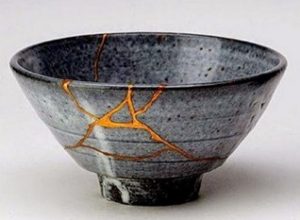There is beauty in imperfection – A tale to ponder – The Cracked Pot:

Fire, earth, air, water – the elements are vital principles in the Universe and in us too
March 22, 2022
An introduction to the Enneagram
April 4, 2022There was a man who earned his living as a water-bearer using two large pots hanging from the ends of a pole, which he supported on his neck. His daily job consisted of carrying the pots full of water from the well to his master’s house.
One of the pots had a crack, while the other was perfect. When the water-bearer arrived at his master’s house, after a long and painful journey, one of the pots was full, while the cracked pot held only half the water. For two years this situation was repeated daily.
The pot that was perfect was proud of its feat, while the other, cracked, lived increasingly ashamed of its imperfection, for feeling unable to produce as much as the other. After carrying this feeling of guilt for two years, the cracked pot then vented its bitterness to the waterman at the edge of the well:
– I am ashamed and I beg your pardon.
– Sorry, why? – Asked the waterman.
– In these two years, I only managed to reach the destination with half a load of water, as this crack causes water to leak along the way and because of my defect, you need to make more trips carrying water and that increases your work.
The water-bearer, having been touched, sad and pitying that old pot, said to him:
“When we get back home, I want you to pay attention to the side of the road.
In fact, as they were going up the mountain, the old cracked pot noticed that one side of the trail it was going through was filled with lush and beautiful flowers. He thought it was beautiful, as he had never noticed them before. But this was still not enough to make him forget his anguish, and at the end of the journey he again apologized to the water-bearer for his clumsiness.
And the water-bearer patiently explained to the pot:
– Did you notice that along the way, there was one on the side of the trail with flowers and that this side was just on your side? So when I noticed your crack, on the first few trips, I took advantage of your defect and decided to sow seeds along that side of the path. Each passing day, your crack leaked water, which watered the plants and during these two years, I was able to smell the flowers and appreciate their beauty, while doing my work!
– This story shows us that it is from our weaknesses that we obtain our greatest strengths .
Perfection does exist when we learn to accept our imperfections, the result of our authenticity and constant work in our evolution. It is a constant polishing of our raw stone, making it clean and shiny.
It is true that a new house can be beautiful, but it is seldom equated with the unique beauty of a rustic house, which has been worked on over the years and whose details have in them the soul and taste of those who built it and for whom there. passed on. An elderly human being does not have the body and beauty of youth, but the scars of experience and the maturity of life end up giving her an interesting and wise image that reflects an already polished character. A computer is perfect in its calculation, but it will not be more inviting than the warmth and affection of a friend, even if it is imperfect, this is because the human being cannot relate and review himself in the perfection that does not exist.
Revealing our imperfections by accepting and embracing them not only strengthens us but also attracts people who are true to us, as people are human and can better relate to authenticity and imperfection.
Perfection also leaves no room for change, improvement, expansion or growth and is static, whereas in imperfection there is a constant growth and evolution which is the natural pulse of life.
In the Japanese tradition there is a philosophy called Wabi Sabi, which has its origins in Zen Buddhism, where we learn to see beauty in imperfect, impermanent and incomplete things. To accept imperfection, asymmetry and irregularity, is to be able to see beauty in everything, even in the most insignificant things in life, even if they are full of flaws and cracks. Wabi Sabi resides in the discreet and forgotten details and it takes a lot of humility and sensitivity to capture them.
Kintsugi or kintsukuroi, is a Japanese technique of repairing ceramic objects by joining them, thus repairing the flaws with resin and a mixture of gold, silver or platinum powder. By doing this, the idea is not to hide the defects, but to value and highlight them, not as defects, but as signs of evolution, creating unique and valuable pieces.

Today’s world is used to camouflaging and hiding our flaws and weaknesses, trying to eradicate them, when perfect, not very genuine people appear on social networks, modified by technological filters and fake smiles.
Let’s embrace our imperfections and find the beauty in them, to live a more serene, joyful and authentic life.
Soon in this blog I will delve into perfection in essence and ego according to Enneagram Type 1. Be aware!


